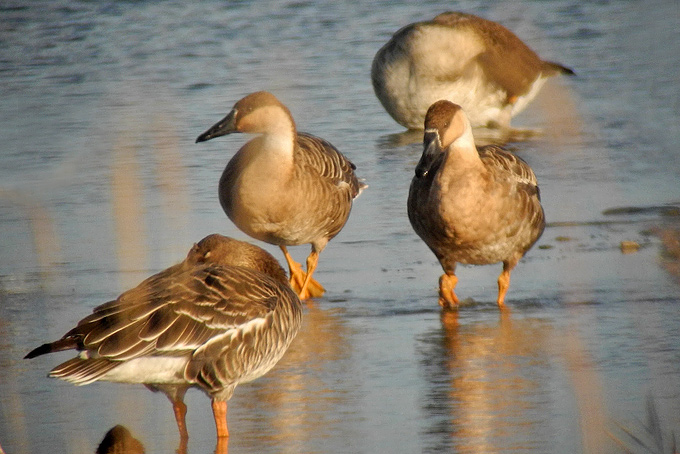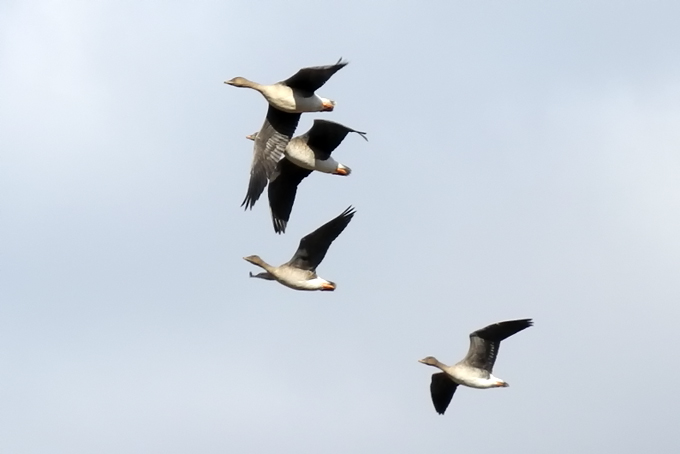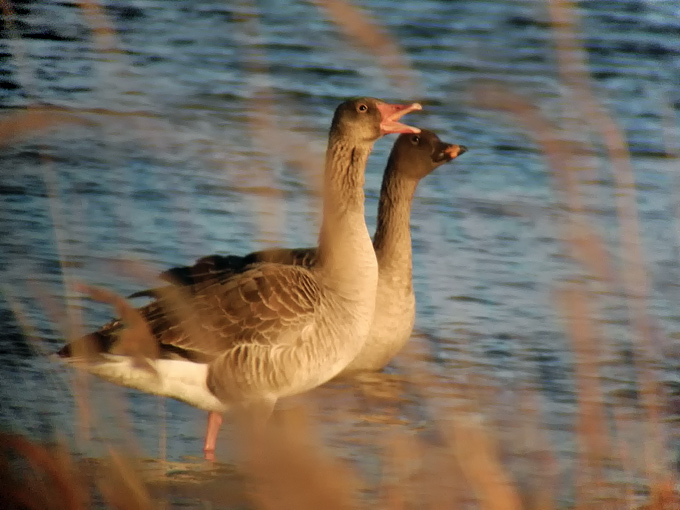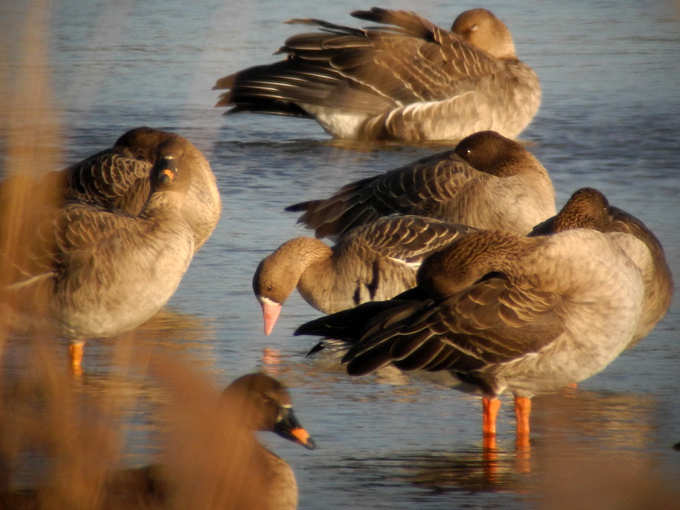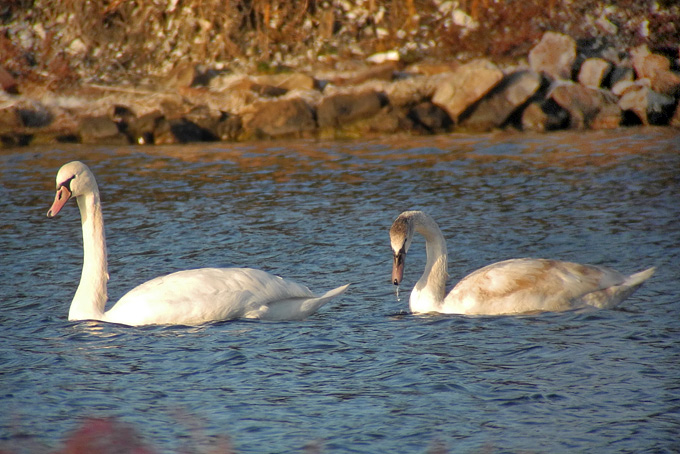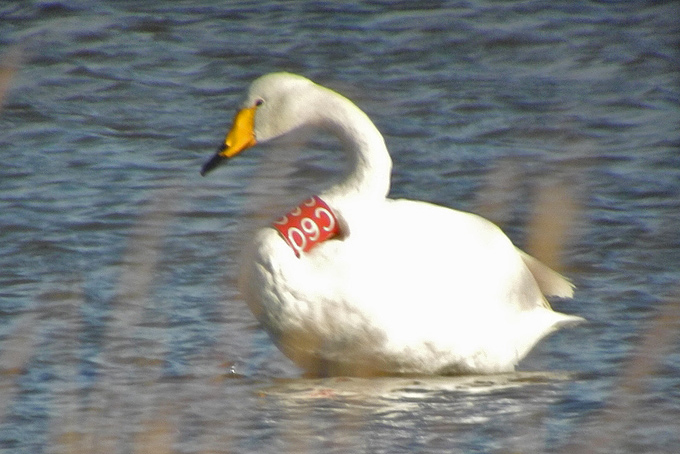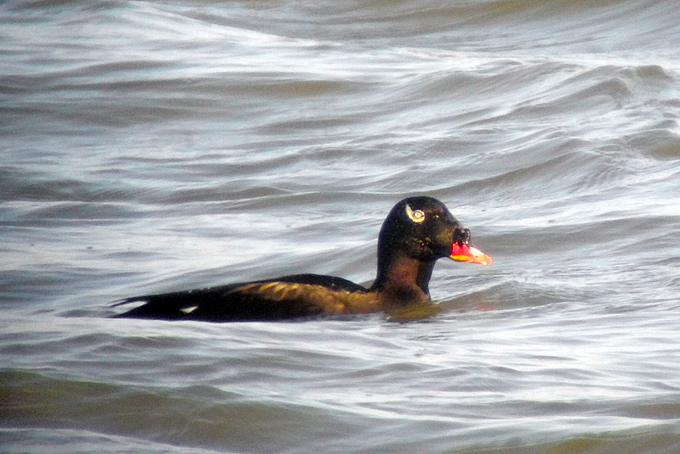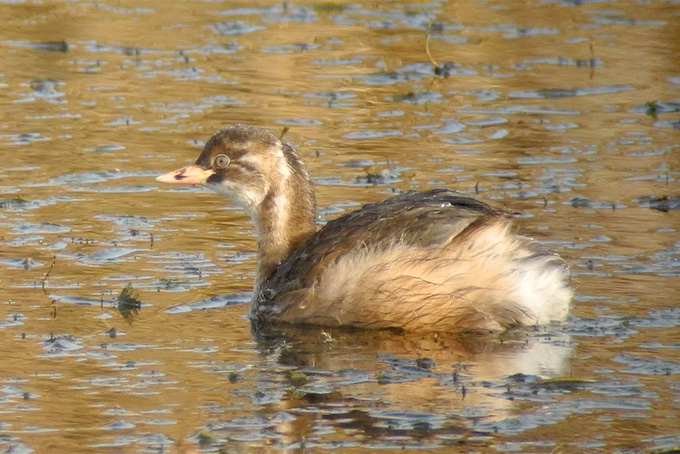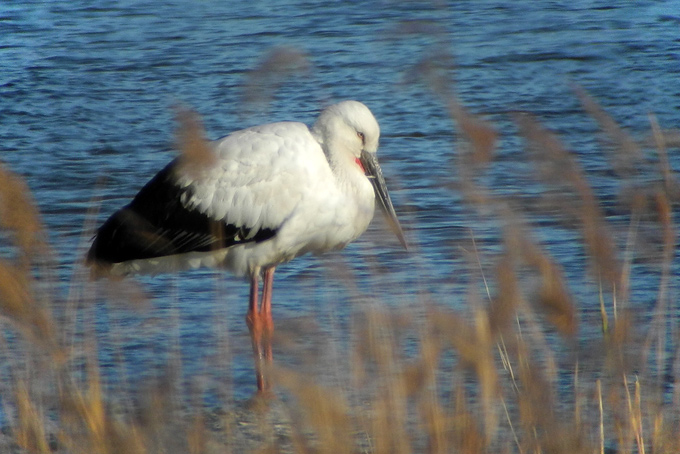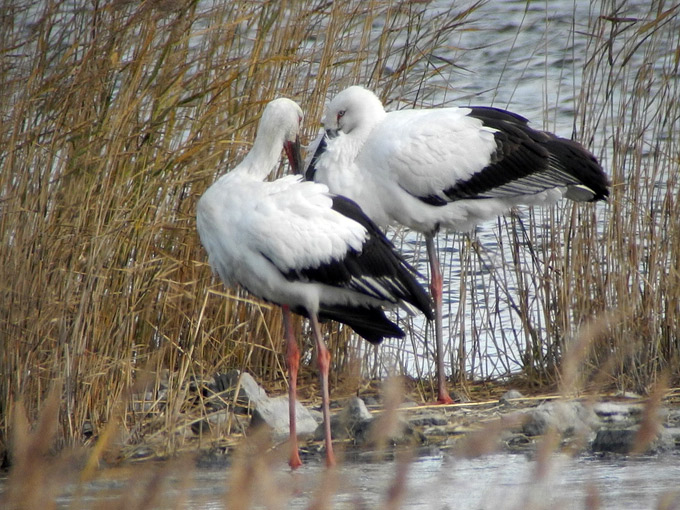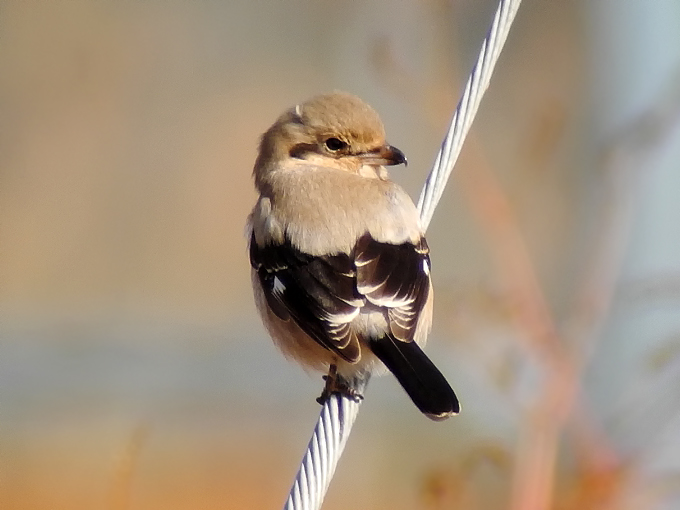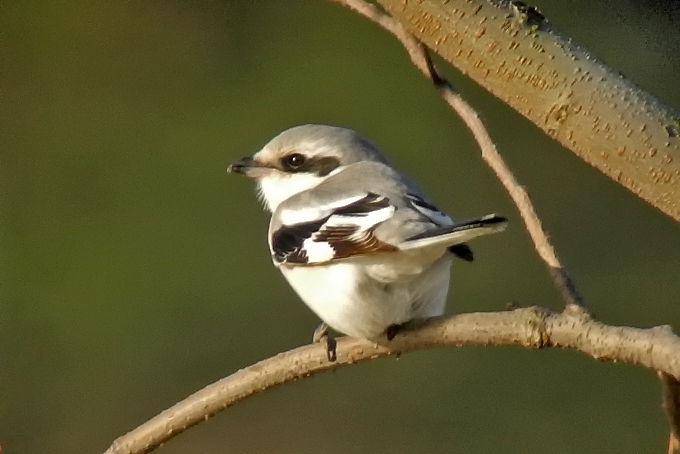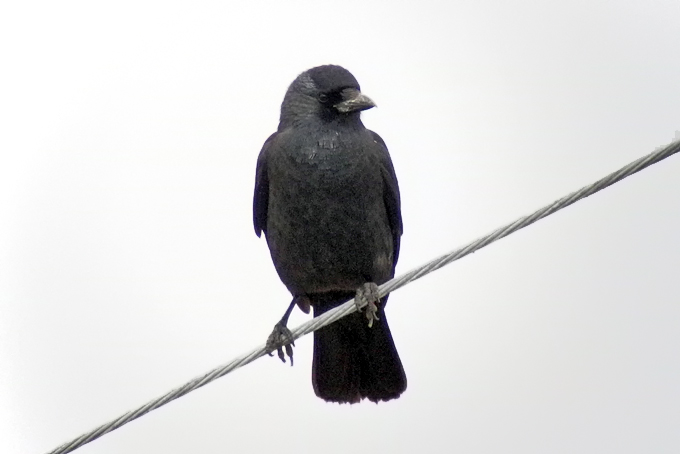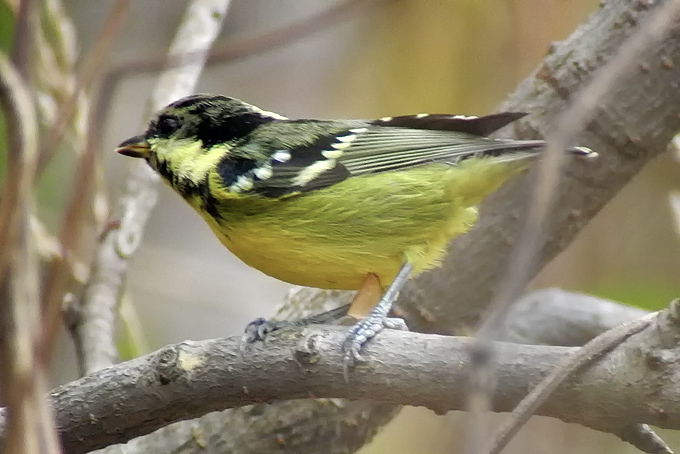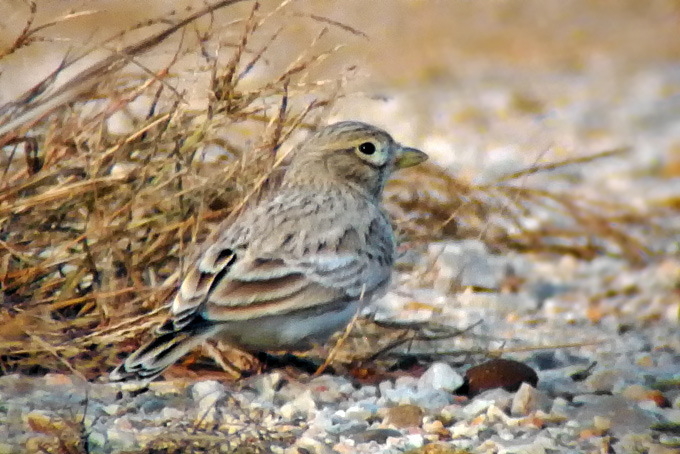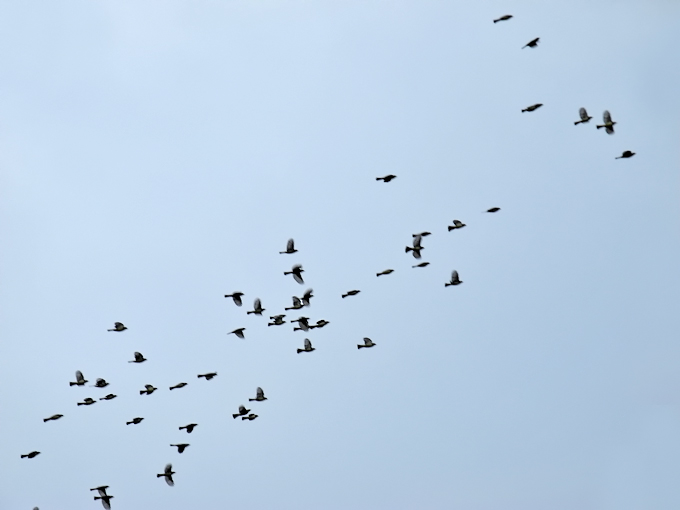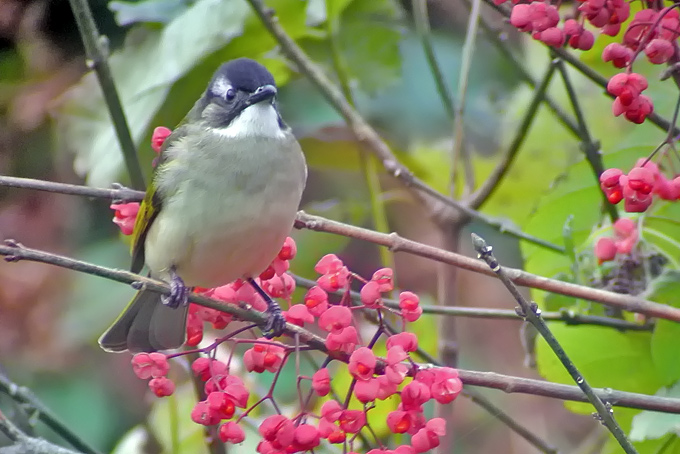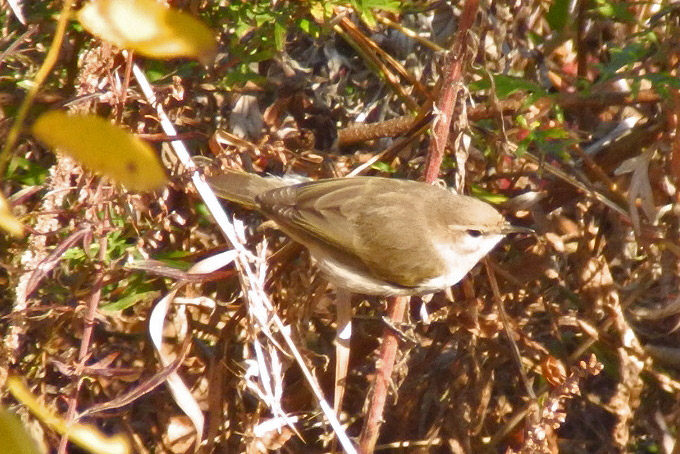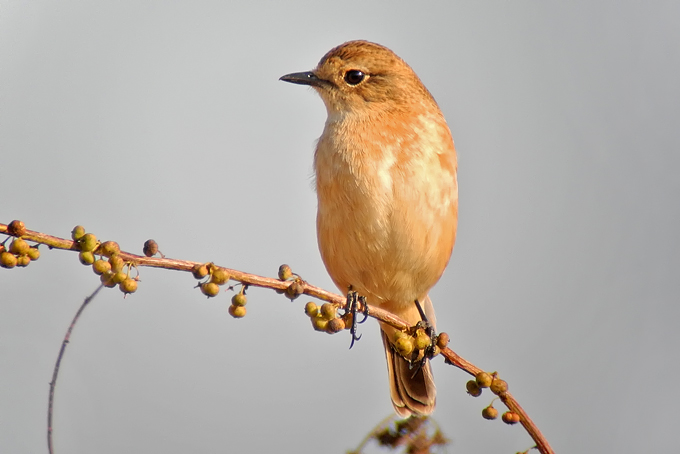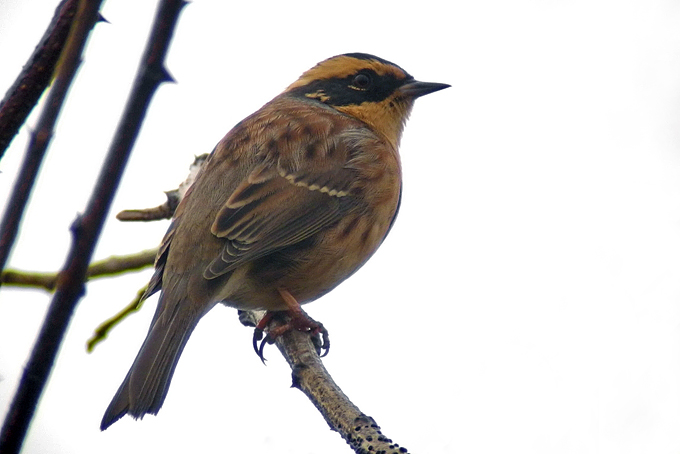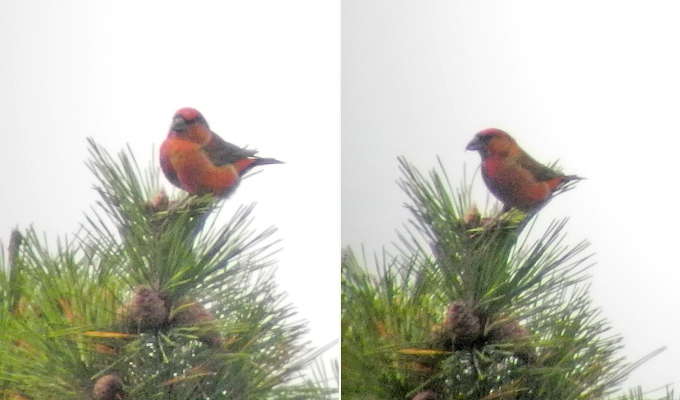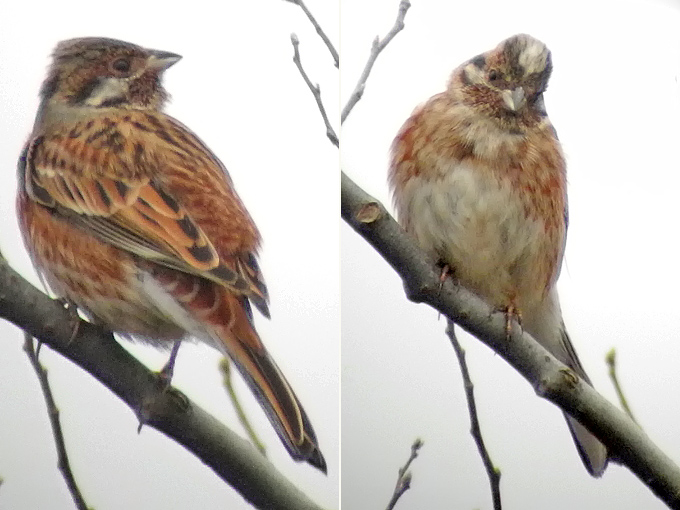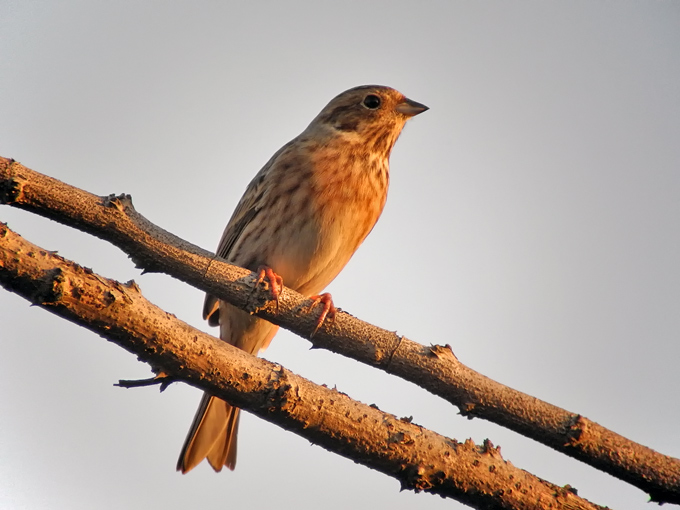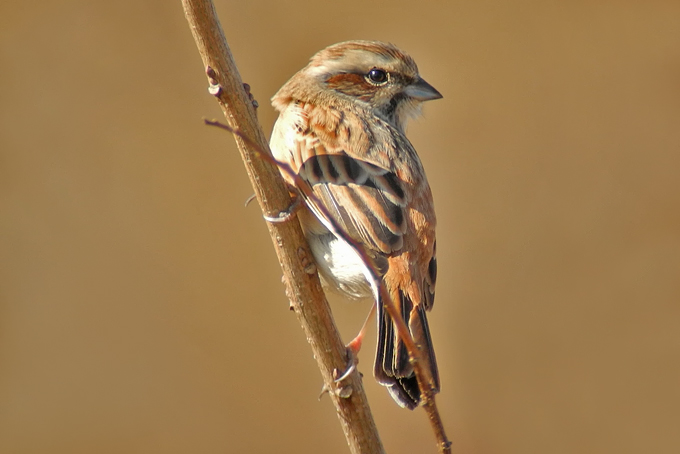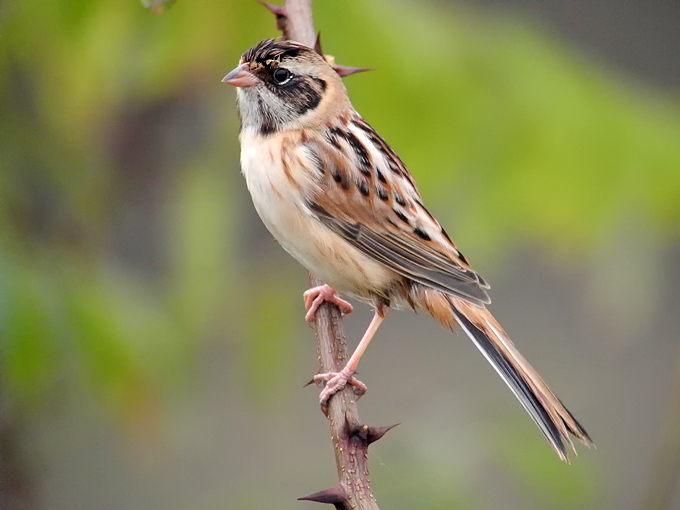After survey visits in March and May, a late autumn survey was conducted on one half-day (November 1st) and ten full days between November 2nd and 12th on Baekryeong Island, Ongjin County. Although this period is outside the main migration period of many landbirds and some raptors, in total I found 144 bird species, with an additional four species – Red-throated Loon Gavia stellata (6), Streaked Shearwater Calonectris leucomelas (1), Pomarine Skua Stercorarius pomarinus (1) and Ancient Murrelet Synthliboramphus antiquus (5) – also seen from the ferry on the return trip to Incheon on 13th. The highest number of species recorded per day was 100 on the 2nd and 98 on the 12th, and the lowest was 58 on the 9th (a day of heavy rain). Areas covered were all surveyed in previous visits and included Yeonhwa Ri (twice), rice-fields around the main reservoir and the reservoir itself (most dates); the “marsh” (most dates); Junghawdong (three times); the Northeast and East coast (on about five dates) and Samgot Ri in the south (twice). For most of these main locations, please refer to: http://www.birdskorea.org/Habitats/Other/Baekryeongdo/BK-HA-Baekryeongdo-May-2013.shtml).
During the first half of November, the weather transitioned on Baekryeong from autumnal (with a high of 18-19C on the 1st and 5th) to more wintery in feel (coolest on 11th, with a minimum of 3C rising to a high of 6C, and Beaufort Force 6 North-westerly winds). Rain fell on the 2nd; 6th and 9th, with most other days largely bright with good visibility.
As anticipated, species diversity and visible migration peaked after the passage of rain. The best areas for seeing landbirds on the move after rain included the Northeast (presumably the main arrival point for some birds, with many birds then moving west or southwest) and the Southwest (where there was much “blogging” in overcast conditions). However, birds were not as obviously funnelled by the geography as on e.g. Socheong.
Compared with previous survey efforts on offshore islands in November (on Socheong and Gageo) some species appeared to be surprisingly uncommon (such as Pale Thrush Turdus pallidus and Black-faced Bunting Emberiza spodocephala) or were not even recorded (e.g. Greater Spotted Eagle Clanga clanga and Dusky Warbler Phylloscopus fuscatus). However, good numbers of several irruptive finch species were logged, and species of greatest ornithological interest included single Greylag Goose Anser anser, Asian Short-toed Lark Calandrella cheleensis and Great Grey Shrike Lanius excubitor; 3-6 Oriental Stork Ciconia boyciana; flocks of Light-vented Bulbul Pycnonotus sinensis and small flocks of Pine Bunting Emberiza leucocephalos; and one possible new subspecies for the ROK: Red Crossbill Loxia curvirostra tianschanica.
As there seems to be little information publicly available about birds on Baekryeong, a full list of species follows below, with highest day counts and a total number of “observations” (an adding of daily totals, therefore potentially including double-counting) given for most species. All these records, comprised of birds heard or seen irrespective of distance, were made by NM, with images taken using a superb Swarovski ‘scope and a hand-held Nikon Coolpix P7100.
- Japanese Quail Coturnix japonica. Noted on only four dates, with 6+ heard in the evening of the 7th the highest number recorded during the period.
- Common Pheasant Phasianus colchicus. Widespread and numerous throughout the island, with birds even seen perched on overhead wires and foraging on open tidal-flat.
- Swan Goose Anser cygnoides. Two were with the Taiga Bean Goose flock in the marsh at Hwadong on the 12th.
- Taiga Bean Goose Anser fabalis. Close views of the goose flock were only obtained from the 7th onwards, when 1,000-1,200 Taiga Bean were present in rice-fields near the main reservoir and in the adjacent marsh at Hwadong. Although very large-bodied, many still appeared shorter-necked and slighter-bodied than many of the Taiga Beans wintering in the southeast of the country (e.g. at Joonam).
- Tundra Bean Goose Anser serrirostris. Close views of the goose flock were only obtained from the 7th onwards. The majority of bean geese (c. 850) on the 4th appeared to be serrirostris. However, there were probably only 50 or so present by the end of the survey period.
- Greylag Goose Anser anser. One was found near the main lake on the 10th, and was still present on the last day of survey on the 12th. This species has been recorded reliably in the ROK probably fewer than ten times (with some recent claims relating to hybrid or domestic geese, as in early 2013, or to confusion with juvenile frontalis Greater White-fronted Goose).
- Greater White-fronted Goose Anser albifrons. Up to three were present within the main goose flock, including one pink-billed adult (perhaps referable to albifrons) and one orange-billed juvenile (most likely from the sometimes unrecognised Northeast Asian frontalis population).
- Mute Swan Cygnus olor. Two (a juvenile and a presumed Second-winter) were present throughout in the marsh. This species is a rare winter visitor to the ROK (with some recent records perhaps related to the growing feral population in Japan?).
- Whooper Swan Cygnus cygnus. Eleven were see flying in from the northwest at midday on the 10th; two were present on the main reservoir that evening; and 11 were present in the marsh on 12th, including one neck-collared bird (“C 60”). According to the EAAFP website (at: http://www.eaaflyway.net/documents/wg/eaaf_anatidae_colormarkings_v2.pdf) , “C60” was initially banded at Sharga Nuur in Mongolia on July 15th 2009, and was then photographed by Dr. Kim Shin-Hwan in Cheonsu Bay on January 8th 2011.
- Ruddy Shelduck Tadorna ferruginea. Two in the marsh on the 10th were still present there on the 12th.
- Gadwall Anas strepera. Present on the main reservoir daily from the 2nd, with a high count of five on the 10th.
- Falcated Duck Anas falcate. Present on the main reservoir daily from the 2nd, with the high count six on the 12th.
- Eurasian Wigeon Anas Penelope. One was on the main reservoir on the 12th.
- Mallard Anas platyrhynchos. The second commonest duck during the survey, with 750 on the 10th the highest day count.
- Eastern Spot-billed Duck Anas zonorhyncha. The commonest duck during the survey, with >100 along the coast and a high count of 950 on the main reservoir on the 7th.
- Northern Shoveler Anas clypeata. Present throughout the survey on the main reservoir with a high count of 15+ on the 10th.
- Northern Pintail Anas acuta. Present throughout the survey in the marsh and on the main reservoir with a high count of only four (on the 10th).
- Baikal Teal Anas formosa. Recorded on five dates on the main reservoir, with four on the 2nd the highest count.
- Eurasian Teal Anas crecca. Recorded on five dates on the main reservoir and in the marsh, with 30 on the 2nd and 20 on 10th and 11th.
- Common Pochard Aythya farina. Up to 25 were present on the main reservoir throughout the survey period.
- Tufted Duck Aythya fuligula. Present throughout the survey period on the main reservoir, increasing from four on 1st to 20 during 10th-12th.
- Greater Scaup Aythya marila. One or two were present on the main reservoir throughout the survey period.
- White-winged Scoter Melanitta deglandi. Present throughout the period in or close offshore from several bays, especially in the southwest of the island. The highest count in a single scan was 140 on the 2nd.
- American Scoter Melanitta americana. Present in small numbers on the east and south coasts, with 15 on 12th the highest count. Of note, all birds seen were adult males – with individuals calling constantly and apparently displaying to each other.
- Common Goldeneye Bucephala clangula. First observed on the 10th (when two were on the main reservoir), increasing to four by the 12th.
- Smew Mergellus albellus. Two were present on the main reservoir on the 12th.
- Common Merganser Mergus merganser. First noted on the 7th, increasing to 15 on the main reservoir by the 12th.
- Red-breasted Merganser Mergus serrator. Recorded on only three dates, with the high count being four on the 2nd.
- Little Grebe Tachybaptus ruficollis. Rather widespread with 40 on the 4th the highest count, and probably more than 100 present on the island. Most of the birds on the main reservoir (25+ most dates) were adults in non-breeding plumage. However, on smaller wetlands, several family groups were heard and seen, with juveniles begging adults (several of which retained much of their breeding plumage). It appears that the species is likely double-brooded on the island (as birds also appeared to be actively paired and in territory here in May).
- Great Crested Grebe Podiceps cristatus. Present in small numbers throughout the survey period, both on the sea (5-10 birds) and on the main reservoir (c. 15 most dates).
- Black-necked Grebe Podiceps nigricollis. Present in small numbers throughout the survey period, with the highest count seven on the 2nd and 12th.
- Oriental Stork Ciconia boyciana. One was seen in flight towards the east on the 1st; two were seen in flight over the marsh on 2nd; and three were together in the marsh from 10th-12th. As a search of rice-fields and wetland areas found no storks between 3rd and 9th it seems that six birds were probably present during the survey period (including birds on active migration). Could the Hwanghaenam-Shandong crossing be used regularly during migration by this species?
- Eurasian Spoonbill Platalea leucorodia. One adult was in the marsh on the 2nd; a First Calendar-year was present there on 6th and 7th; and there was one there on the 10th, three on the 11th and four on the 12th.
- Grey Heron Ardea cinerea. Present throughout, with 20 on the 4th the highest day count.
- Great Egret Ardea alba. Present throughout the survey, with five modesta and five alba on 2nd, and 10+ alba on 11th and 12th.
- Intermediate Egret Egretta intermedia. One on the 2nd, two on the 4th and the last singles seen on the 5th and 6th.
- Little Egret Egretta garzetta. Singles recorded on 4th and 12th were the only records.
- Chinese Egret Egretta eulophotes. One, with a damaged wing, was first found on the main beach on the 12th. As this was the first day to check this area the bird might already have been present for some time.
- Pelagic Cormorant Phalacrocorax pelagicus. Present throughout the survey period, mostly in the west and southwest, with the high count 45+ on the 7th.
- Temminck’s Cormorant Phalacrocorax capillatus. Widespread and fairly numerous with 150+ recorded on several dates.
- Western Osprey Pandion haliaetus. Present throughout, with a high count of four on the 4th, decreasing to just one on the 11th and 12th.
- Japanese Sparrowhawk Accipiter gularis. A total of 12 “observations” during the survey, with the high count three on the 7th.
- Eurasian Sparrowhawk Accipiter nisus. Recorded daily, with a total of 22 “observations” and a peak of four on 5th and 7th.
- Northern Goshawk Accipiter gentilis. Observed daily, with a total of 19 “observations” (most of which were juveniles), including a peak of 3+ on 4th and a huge grey-toned adult on 12th.
- Black Kite Milvus migrans. Small numbers (mostly First year birds, though some adults) were recorded daily, with 15 (mostly in the west) on 4th and on the 9th, 14 watched going to roost in Jincheon in the east being the highest day counts.
- Upland Buzzard Buteo hemilasius. A pale morph adult was present north of the main reservoir from 4th to the survey end, with a second bird (presumably a First-winter) also seen by the main reservoir on the 10th.
- Eastern Buzzard Buteo japonicus. The most numerous raptor during the survey, seen daily, with a total of c.100 “observations” and a peak count of 25 on the 7th.
- Common Kestrel Falco tinnunculus. Seen daily, with a total of 24 “observations” and a peak of four on 4th. Most appeared heavily marked, though at least two appeared to be obviously paler and might have been perpallidus.
- Amur Falcon Falco amurensis. A juvenile on the 1st was the only record.
- Eurasian Hobby Falco subbuteo. One late adult was seen in the east on the 5th and in the west on the 6th.
- Peregrine Falcon Falco peregrinus. Between one and five were seen daily. Two peregrine-sized brown-backed falcons (one with contrastingly darker wing-tips) seen distantly on the 4th were either juvenile Peregrine migrating across the island or instead Saker Falcons F. cherrug.
- Brown-cheeked Rail Rallus indicus. One seen in the marsh on 2nd, and another probable was heard at the main reservoir the same day.
- Eurasian Coot Fulica atra. One was on the main reservoir on the 12th.
- Northern Lapwing Vanellus vanellus. Between two and four were in Hwadong on the 4th, with singles seen also on the 6th, 7th and 12th.
- Common Snipe Gallinago gallinago. One was heard (probably departing) an hour after sunset on 7th.
- Far Eastern Curlew Numenius madagascariensis. One on the remaining tidal-flat in the southeast on the 2nd and 9th appeared to have a damaged wing.
- Green Sandpiper Tringa ochropus. One was in the marsh on the 7th.
- Black-headed Gull Chroicocephalus ridibundus. Two on the 2nd was the only record.
- Black-tailed Gull Larus crassirostris. The most numerous gull species, seen daily, with 300+ on the 6th the highest day count.
- Vega Gull Larus vegae. Recorded almost daily, with a peak count of 10 on the 10th.
- Mongolian Gull Larus mongolicus. Recorded almost daily in small numbers, with a high count of 15 on the 11th.
- Heuglin’s Gull Larus heuglini. Seen only on the 10th and 11th during strong northerly winds when 8+ were on the remaining tidal-flat in the southeast. All were taimyrensis.
- Oriental Turtle Dove Streptopelia orientalis. Seen daily, with 30+ seen on several dates (with no clear evidence of movement).
- Northern Scops Owl Otus semitorques. An owl giving a “whoop” call at forest edge on the 2nd and two owls giving a range of calls (including a rapidly-repeated “whoop” and a lapwing-like “ee-veet”) on the 6th and 7th in a different area were likely to be this taxon. Very poor recordings were made which will later be compared with recordings of owls of known identity. Any recordings of owl taxa or links to such recordings will be gratefully received (and acknowledged)…
- Long-eared Owl Asio otus. One was seen briefly in Samgot Ri on 10th.
- Great Spotted Woodpecker Dendrocopos major. Singles were seen in different parts of the island on 2nd, 3rd and 5th.
- Ashy Minivet Pericrocotus divaricatus. One very late migrant was heard and seen in high flight towards the northwest on the 6th.
- Bull-headed shrike Lanius bucephalus. Recorded daily in small numbers, with the highest count ten on the 6th.
- Great Grey Shrike Lanius excubitor. A First-winter sibiricus was in Samgot Ri on the 10th. This is probably only the second record of this subspecies in the ROK (the last being one on Socheong on October 24th 2009). The species is still listed as V2 by Birds Korea (i.e. less than ten records nationally).
- Chinese Grey Shrike Lanius sphenocercus. One first seen north of the main reservoir on the 6th was still present in the same area on the 12th.
- Eurasian Jay Garrulus glandarius. Noted daily, with several small flocks in sustained flight and a high count of 25 on the 5th.
- Azure-winged Magpie Cyanopica cyanus. Apparently more localised than in May, being recorded on only five dates and only in the west of the island (with a high count of 10 in Junghwadong and 1-2 in Yeonhwa Ri).
- Eurasian Magpie Pica pica. Recorded on seven dates, with the high count only three.
- Daurian Jackdaw Coloeus dauuricus. Recorded on five dates, with eight on the 3rd and 4th and 3-5 from the 9th to the 12th.
- Rook Corvus frugilegus. Recorded on seven dates, first from 3rd, with the high count 100+ on 10th.
- Large-billed Crow Corvus macrorhynchos. Recorded daily, with the high count 20 on the 2nd but less than 10 found each day from the 10th to 12th despite coverage of much of the island.
- Coal Tit Periparus ater. Recorded daily, with a total of 230 “observations”, and the highest day count 75+ on 5th. Some birds were seen in high flight, suggesting intended emigration.
- Yellow-bellied Tit Periparus venustulus. Recorded on eight dates and in several parts of the island, with 28 “observations” and the highest day counts of eight on the 5th and 6-8 on the 9th. Of note, this species was recorded (and banded) in early October this year at Muraviovka Park in Russia (see: http://www.amurbirding.blogspot.kr/search?updated-max=2013-10-14T17:51:00%2B10:00&max-results=7), probably the first Russian record. The species appears to be continuing to expand its range rapidly north-eastward. Before the first ROK record in 2005, and recent records in Japan, the species was considered to be endemic to China.
- Eastern Great Tit Parus minor. Recorded daily, with 152 “observations” and high counts of 25 on the 5th and 10th.
- Chinese Penduline Tit Remiz consobrinus. Recorded on only five dates, with the high count 3+ on 1st.
- Asian Short-toed Lark Calandrella cheleensis. One strikingly pale individual was on one of the main tracks through the rice-fields on 1st, heard again there on the 4th and was perhaps seen briefly in the same area again on 11th (but not on 12th, despite much searching). Of note, between one and three were reported in Gangneung on the northeast coast of the mainland on the 1st, with at least one still present there on the 3rd.
- Eurasian Skylark Alauda arvensis. Recorded on seven dates, with the highest day count 15 on the 12th.
- Far Eastern Skylark Alauda japonica. One was present on 1st and 2nd.
- Light-vented Bulbul Pycnonotus sinensis. Recorded daily, with 317 “observations’. A single flock of 30 was present in the northeast on the 3rd. This seemed remarkable (in the Korean context – as the species was only first recorded in the ROK in late October 2002), until 65 were seen in a single flock in the southwest on the 9th, with at least 85 present in the same area on 11th. Of interest a flock “many hundred in number” were reported at Laoteishan in Liaoning, China (one major peninsula north from Hwanghaenam / Baengryeong) on November 8th (see: http://www.birdforum.net/showthread.php?t=165968&page=39). Like the Yellow-bellied Tit (and a few other small to medium sized landbirds tolerant of artificial or degraded habitats), this species has expanded its range north-eastwards massively during the past decade.
- Brown-eared Bulbul Hypsipetes amaurotis. Recorded daily, with 305 “observations” and a high count of 50+ on the 6th.
- Barn Swallow Hirundo rustica. Recorded only between 3rd and 6th, with a high count of ten.
- Asian House Martin Delichon dasypus. A single on the 3rd was the only record.
- Red-rumped Swallow Cecropis daurica. Two on the 6th was the only record.
- Korean Bush Warbler Horornis borealis. Recorded on six dates, with 11 “observations” and a high count of three on both the 2nd and 6th.
- Long-tailed Tit Aegithalos caudatus. Presumably present throughout but only seen / heard on seven dates, with a high count of eight on 5th. All individuals seen were white-headed.
- Siberian Chiffchaff Phylloscopus collybita. One tristis was digiscoped poorly in the southeast of the island on the 5th. Although increased observer activity might explain some of the recent increase in records in the ROK of this species, it also seems probable that it is occurring more frequently now than only a decade ago (personally, this is about my ninth record of the species in the ROK – with all but two being in the past three years).
- Radde’s Warbler Phylloscopus schwarzi. Singles were heard and seen on the 2nd and 5th.
- Pallas’s Leaf Warbler Phylloscopus proregulus. Remarkably scarce (considering its status in November on Socheong and Gageo), with one on the 7th the only record.
- Yellow-browed Warbler Phylloscopus inornatus. Recorded daily until the 7th, with a peak count of 7+ on the 2nd, and the last record one on 12th.
- Far Eastern Cisticola Cisticola juncidis. One on the 4th was the only record.
- White-eye sp. Zosterops sp. One heard on the 2nd was the only record.
- Goldcrest Regulus regulus. Fairly numerous and widespread, recorded daily with 220 “observations” and a peak count of 50+ on the 5th.
- Eurasian Wren Troglodytes troglodytes. Recorded daily with 35 “observations”, with 5+ on the 9th and 12th the highest day counts.
- White-cheeked Starling Spodiopsar cineraceus. Recorded on eight dates, with the highest day count four on the 3rd.
- Common Starling Sturnus vulgaris. Two (one First-winter and one non-breeding adult) were in Junghawdong on the 2nd.
- Grey-backed Thrush Turdus hortulorum. One on the 4th and another on the 5th were the only records.
- Pale Thrush Turdus pallidus. One on the 5th was the only record.
- Red-throated Thrush Turdus ruficollis. An adult male was seen briefly on the 2nd in the southeast. Most thrushes, however, were extremely secretive and / or flighty so most (several hundred “Dusky-Naumann-Darkthroats”) were not identified to species.
- Naumann’s Thrush Turdus naumanni. Recorded certainly on only five or so dates – with all 28 thrushes seen properly out of 200 in flight over the southeast of the island on the 12th being this species.
- Dusky Thrush Turdus eunomus. Recorded almost daily. With most of the 120 thrushes seen in flight on the 2nd thought to be this species.
- Siberian Rubythroat Luscinia calliope. Surprisingly scarce, with only two heard (singles on the 5th and 9th) during the survey.
- Red-flanked Bluetail Tarsiger cyanurus. Remarkably scarce considering its status on other islands in late October and early November, being recorded on only six dates with two on the 3rd and 5th the highest day count.
- Daurian Redstart Phoenicurus auroreus. Recorded daily, with 114 “observations”, including highest day counts of 20 on the 2nd and 5th.
- Stejneger’s Stonechat Saxicola stejnegeri. Recorded almost daily, with 28 “observations” including a peak count of six on the 11th.
- Blue Rock Thrush Monticola solitarius. One philippensis on the 3rd was the only record.
- Eurasian Tree Sparrow Passer montanus. Present in every village and town on the island in small numbers (10-30), with the highest day count 50 (on the 12th) and an island population of probably several hundred.
- Siberian Accentor Prunella montanella. Recorded on only four dates, with ten on the 5th, 6+ on the 6th, 10+ on the 9th and at least 18 (all in the east of the island) on the 12th.
- Eastern Yellow Wagtail Motacilla tschutschensis. Only one record: one in Samgot Ri on the 12th.
- Grey Wagtail Motacilla cinerea. Singles were recorded on three dates (last on the 9th).
- White Wagtail Motacilla alba. Recorded daily, with 92 “observations”, and the highest day counts of 35 on the 2nd and 30 on the 6th. Three subspecies were recorded, with ocularis the most numerous, and only 2-3 leucopsis and a total of five lugens.
- Richard’s Pipit Anthus richardi. Singles were recorded on the 2nd, 4th and 5th.
- Olive-backed Pipit Anthus hodgsoni. Recorded in small numbers daily, with 90 “observations” and a peak count of 20 on the 2nd.
- Red-throated Pipit Anthus cervinus. One or two recorded on seven dates, most regularly until 7th, though with one or two still present also on the 12th.
- Buff-bellied Pipit Anthus rubescens. The commonest pipit, recorded daily, with 106 “observations”, with 25+ on the 2nd and 20+ on the 12th the highest day counts.
- Brambling Fringilla montifringilla. The most numerous landbird during the survey period, especially during the first week. There was a total of 5,520 “observations” with a high count of 1,500 on the 2nd (including one flock of 600 in Jincheon). Migration seemed to trail off after the 9th (when 700 were seen in the west of the island).
- Hawfinch Coccothraustes coccothraustes. Recorded daily from the 2nd, with 105 “observations”, including the highest day count of 20+ on the 2nd and 3rd.
- Chinese Grosbeak Eophona migratoria. Recorded on four dates, with five in the west on the 2nd; five in the east on the 3rd; one on the 9th and three in the east on the 12th.
- Eurasian Bullfinch Pyrrhula pyrrhula. Recorded daily in small numbers from the 5th, with 20 “observations”. Most records were of calling birds in high overhead flight so none were identified to subspecies.
- Common Rosefinch Carpodacus erythrinus. Recorded on seven dates, daily until the 7th and then again on 12th (a single). The highest day count was 10, on the 2nd, when an adult male was also seen (at Junghwadong).
- Long-tailed Rosefinch Carpodacus sibiricus. Recorded in small numbers (1-3) on eight dates.
- Pallas’s Rosefinch Carpodacus roseus. Recorded daily only between the 2nd and the 6th, with 23 “observations” in total including a high count of eight on the 2nd.
- Grey-capped Greenfinch Chloris sinica. Found in steadily increasing numbers throughout the survey period, with the highest count 75+ on the 12th. Many of the vocalisations sounded distinctly different from those given by birds in south-eastern ROK.
- Common Redpoll Acanthis flammea. Redpolls were recorded in overhead flight on six dates, with eleven “observations” including a high count of four on the 12th. Only two birds were seen reasonably well – both were Common Redpoll. It seems possible that 2013/ 2014 might be a decent winter for the species in the ROK and the wider region (with birds also reaching Beijing on November 3rd: http://birdingbeijing.com/).
- Red Crossbill Loxia curvirostra. Recorded daily until the 9th, with a single outlier on the 12th and a total of 288 “observations” including c. 100 on the 2nd. Most birds were seen only in flight and appeared to be remarkably (and atypically) shy. As can be seen in a couple of very poor record shots, those males that were seen well (a dozen or more) appeared all-red below, lacking the paler sometimes streaked vent often shown by subspecies japonica (the only subspecies so far claimed in the ROK). As we also found the first Red Crossbill for Rudong County (Jiangsu Province, China) this October which was similarly all- red below, it is tempting to consider that these birds might well be originating from further west than in normal irruptions. Of note, Brazil’s East Asia field-guide states that subspecies tianschanica of “of C Asia and W China winters to Liaoning and Hebei” and images of this subspecies from Kazakhstan (http://www.birds.kz/subspeciesbest.php?sspecies=627&l=en) seem closer to those seen on Baekryeong than most images of japonica (including those in our gallery at: http://www.birdskorea.org/Gallery/Species/BK-GA-Loxia-curvirostra.shtml). It would be great to see more (and much better!) images of this taxon / these taxa this winter!
- Eurasian Siskin Spinus spinus. Recorded daily with 1250 “observations” including the highest day count of 250 on the 9th.
- Pine Bunting Emberiza leucocephalos. Recorded on eight dates, with 45 “observations” (involving probably 35-40 individuals in total). Observations of this typically scarce species were as follows: 5-6 on the 6th; 10-17 on the 3rd; 11-12 on the 4th; three on the 5th and 6th; one on the 7th and 11th and two on the 12th. Probably ten adult males were seen, showing a very wide range of plumage features, from much black to almost no black on the crown sides. One female type seen in flight only on the 3rd, appeared weakly yellow below – but could not be re-found despite much searching.
- Meadow Bunting Emberiza cioides. Widespread in more open areas. Recorded daily, with 228 “observations” and a highest day count of 40 on both the 6th and the 12th.
- Tristram’s Bunting Emberiza tristrami. Recorded on only three dates, with three on the 2nd, and 2+ on the 9th and 10th.
- Chestnut-eared Bunting Emberiza fucata. Recorded on six dates, with the highest count 3+ on 5th.
- Little Bunting Emberiza pusilla. Recorded daily, with 133 “observations” and highest day counts of 30 on the 6th and 20 on the 12th.
- Yellow-browed Bunting Emberiza chrysophrys. A female was in Junghwadong on the 9th and 11th.
- Rustic Bunting Emberiza rustica. The most numerous bunting, especially until the 6th, with a total of 2,400 “observations”, more than half of which were between the 2nd and the 6th. The highest day counts were 800 on the 2nd and 500 on the 6th. Numbers were lowest on the 10th (when only 10 were logged) recovering somewhat to 120 by the 12th.
- Yellow-throated Bunting Emberiza elegans. The second most numerous bunting with 995 “observations” and the peak in number on 5th and 6th when 150+ and 200 respectively were counted.
- Chestnut Bunting Emberiza rutila. Singles on three dates with two on the 6th the highest day count and the final observation.
- Black-faced Bunting Emberiza spodocephala. Remarkably scarce, being recorded on only eight dates, with a total of only 14 “observations” including a high count of five (on the 4th).
- Pallas’s Reed Bunting Emberiza pallasi. Recorded daily, with 141 “observations” and a high day count of 30 on the 1st
- Ochre-rumped Bunting Emberiza yessoensis. Recorded on four dates, with at least eight “observations” and a high count of c.5 on the 2nd.
- Common Reed Bunting Emberiza schoeniclus. Recorded almost daily, with 75 “observations” and highest day counts of 25+ on the 3rd and 20+ on the 6th.
- Lapland Longspur Calcarius lapponicus. Recorded on seven dates, with 1-3 most dates, and a high count of 26+ on the 4th.
